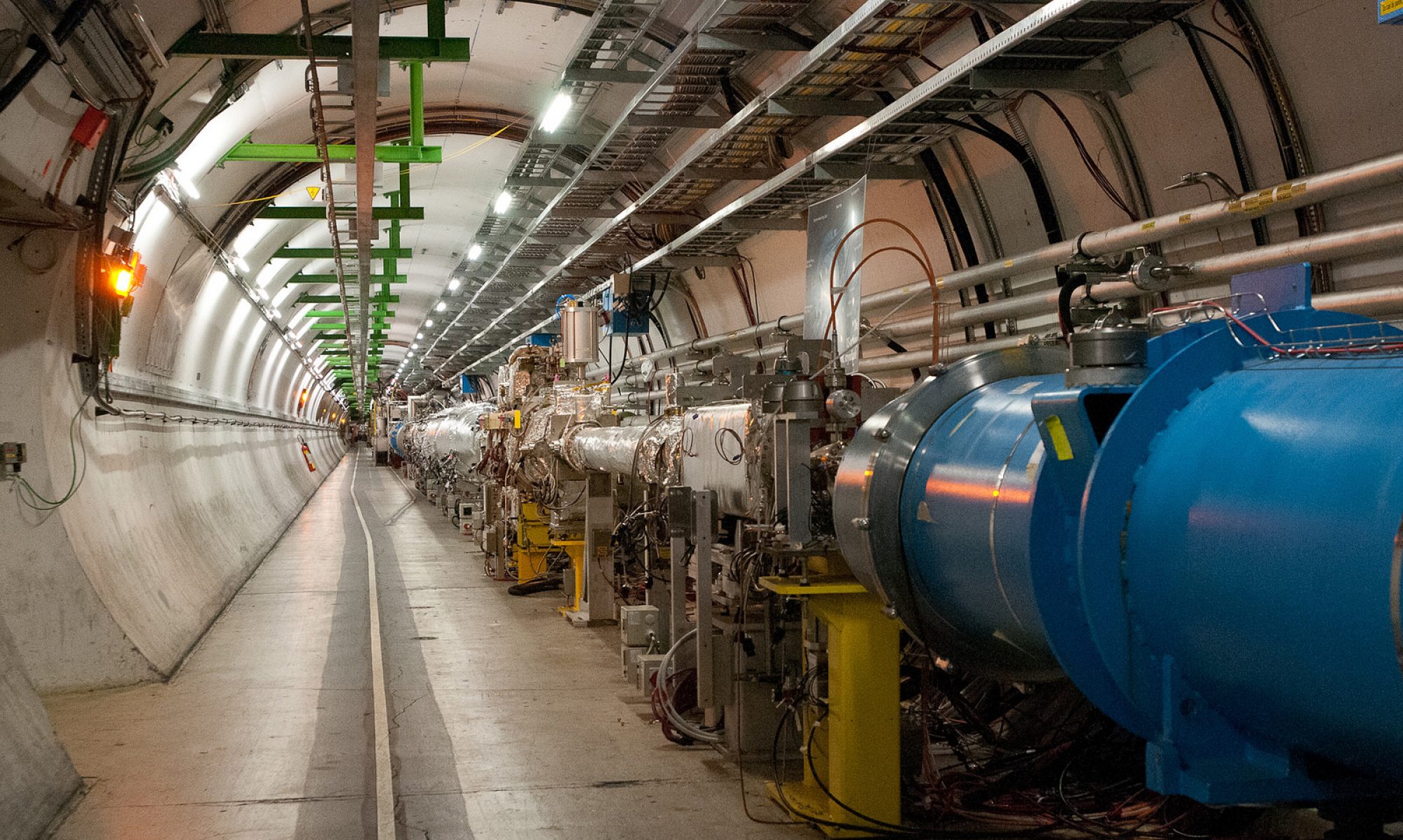In preparation for the upcoming Moriond Conferences in Italy, I summarize the state of what was known about the new 125 GeV state in 2012. We all expect ATLAS and CMS to have more to say once the Moriond Conferences arrive, so think of this as a VERY brief primer on what was known about the new state as of December, 2012 – the last time public results were circulated by the two collaborations.
The Discovery of a Higgs-Like Boson at the LHC
The discovery of a boson whose properties are so far consistent with the Standard Model (SM) Higgs Boson marks an incredible achievement for the Standard Model. The boson has a mass that is about 125 GeV, and has been measured with precision in two channels by both the ATLAS and CMS collaborations. The precision channels available so far for measuring Higgs properties such as mass, spin, and the CP quantum numbers are ![]() and
and ![]() . The masses measured by the two collaborations in each of the two channels are reported to be [1][2][3]:
. The masses measured by the two collaborations in each of the two channels are reported to be [1][2][3]:
ATLAS:
(1) ![]()
CMS:
(2) ![]()
CMS does not report a mass measurement alone in the ![]() channel, but instead combines the two high-mass channels into a single mass result. The ATLAS and CMS masses reported by combining the high-resolution channels are [4][5]:
channel, but instead combines the two high-mass channels into a single mass result. The ATLAS and CMS masses reported by combining the high-resolution channels are [4][5]:
ATLAS:
(3) ![]()
CMS:
(4) ![]()
The figures below illustrate the scans of signal strength (observed signal relative to SM expectation) vs. mass, including the 1-sigma contours for each high mass-resolution channel and their combination.
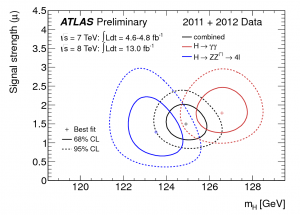
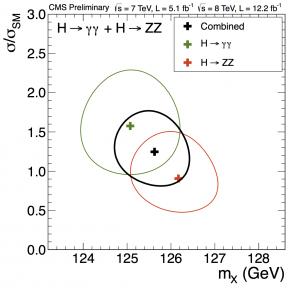
The two collaborations have used many channels overall to both discover the new boson and measure its properties. So far, the reported channels have been ![]() . The latter three channels have been more statistically challenging due to confounding factors of experimental mass resolution, background subtraction, and selection efficiency. However, both collaborations continue to demonstrate cycles of improvement in these issues with each newly unveiled result.
. The latter three channels have been more statistically challenging due to confounding factors of experimental mass resolution, background subtraction, and selection efficiency. However, both collaborations continue to demonstrate cycles of improvement in these issues with each newly unveiled result.
Overall, the results from these channels have been largely consistent with the expectation from the SM. Causing the most conversation in the community, the ![]() channel reported by both experiments has shown a consistent excess above the SM expectation. Whether this apparent excess will continue to remain with improvement in available data, experimental methods, and theoretical calculations, is to be seen. Significant excesses necessary to claim independent observation in the
channel reported by both experiments has shown a consistent excess above the SM expectation. Whether this apparent excess will continue to remain with improvement in available data, experimental methods, and theoretical calculations, is to be seen. Significant excesses necessary to claim independent observation in the ![]() channels are still not announced.
channels are still not announced.
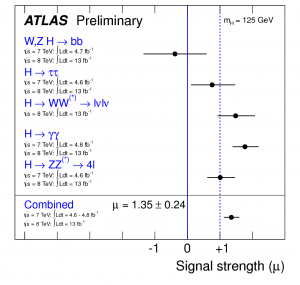
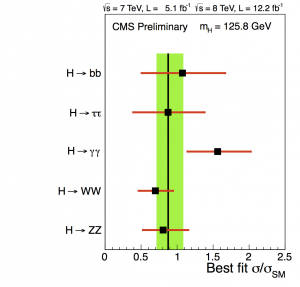
The spin of the new boson is another property that is accessible through the detailed study of the channels with significant excesses (![]() ). The observation of the new particle decaying at all to these final states establishes its nature as a boson; it it not possible to achieve the observed final states unless the spin of the parent is an integer. Due to its decay into the
). The observation of the new particle decaying at all to these final states establishes its nature as a boson; it it not possible to achieve the observed final states unless the spin of the parent is an integer. Due to its decay into the ![]() final state, and given the configurations of Z boson spin allowed in the decay, it’s possible that the boson is spin-0, 1, or 2. Due to its decay into the
final state, and given the configurations of Z boson spin allowed in the decay, it’s possible that the boson is spin-0, 1, or 2. Due to its decay into the ![]() final state and the allowed polarizations of the final-state photons, the spin of the parent could be either spin-0 or 2. Since there is some tension in the values of the mass measurements from these two final states from both collaborations (albeit in opposite directions!), it is possible that both experiments have discovered a pair of bosons that are close in mass; one of those bosons could be spin-0, 1, or 2 and decays primarily to
final state and the allowed polarizations of the final-state photons, the spin of the parent could be either spin-0 or 2. Since there is some tension in the values of the mass measurements from these two final states from both collaborations (albeit in opposite directions!), it is possible that both experiments have discovered a pair of bosons that are close in mass; one of those bosons could be spin-0, 1, or 2 and decays primarily to ![]() while the other is either spin-0 or 2 and decays primarily to
while the other is either spin-0 or 2 and decays primarily to ![]() . Absent observations of the angular distributions of final-state particles (leptons from the Z bosons, or the final-state photons in the
. Absent observations of the angular distributions of final-state particles (leptons from the Z bosons, or the final-state photons in the ![]() channel), one cannot determine the actual spin of the parent for either of these hypotheses (the 1-parent hypothesis, or the 2-parent hypothesis).
channel), one cannot determine the actual spin of the parent for either of these hypotheses (the 1-parent hypothesis, or the 2-parent hypothesis).
ATLAS and CMS have reported on some of the angular distributions of the final-state particles in these decays. Both collaborations test Spin-CP (![]() ) hypotheses against one another to determine which is more probably given the data. CMS has tested the 0+ hypothesis against the 0- hypothesis; ATLAS has tested the 0+ hypothesis against 0-, 2+<sub>m</sub>, and 2- hypotheses [5] in the 4-lepton final state. Both experiments only have reported their measurements as comparisons of 0+ to any of the other spin hypotheses, employing the prediction that the SM Higgs Boson will have a 0+ spin-CP configuration. However, so far neither collaboration has reported tests of 0+ against 1+ or 1-, leaving open the possibility that they have found two new bosons each with different
) hypotheses against one another to determine which is more probably given the data. CMS has tested the 0+ hypothesis against the 0- hypothesis; ATLAS has tested the 0+ hypothesis against 0-, 2+<sub>m</sub>, and 2- hypotheses [5] in the 4-lepton final state. Both experiments only have reported their measurements as comparisons of 0+ to any of the other spin hypotheses, employing the prediction that the SM Higgs Boson will have a 0+ spin-CP configuration. However, so far neither collaboration has reported tests of 0+ against 1+ or 1-, leaving open the possibility that they have found two new bosons each with different ![]() quantum numbers. They have also not compared all other possible combination of spin-CP hypothesis against one another.
quantum numbers. They have also not compared all other possible combination of spin-CP hypothesis against one another.
Of the hypothesis tests that have been conducted, the new boson(s) are most consistent with the 0+ hypothesis.
![From ATLAS-CONF-2012-169, "Distributions of the log-likelihood ratio generated with more than 50,000 Monte Carlo pseudo-experiments when assuming the spin 0+ hypothesis and testing the 0- . . . [hypothesis]. In each experiment the expected number of signal and background events is fixed to the observed yields. The data are indicated by the solid vertical lines, and the median of each of the expected distributions is indicated by a dashed line. The shaded areas correspond to the observed pval-values, representing the compatibility with the tested hypothesis H1 (right shaded area) and the assumed hypothesis H0 (left shaded area)."](http://steve.cooleysekula.net/goingupalleys/wp-content/uploads/2013/02/fig_20a-300x291.png)
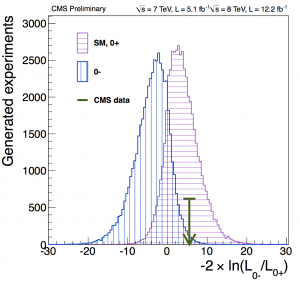
[1] The ATLAS Collaboration. “An update of combined measurements of the new Higgs-like boson with high mass resolution channels.” ATLAS-CONF-2012-170. http://cds.cern.ch/record/1499629
[2] The CMS Collaboration. “Updated results on the new boson discovered in the search for the standard model Higgs boson in the ZZ to 4 leptons channel in pp collisions at sqrt(s) = 7 and 8 TeV.” CMS-PAS-HIG-12-041. http://cds.cern.ch/record/1494488?ln=en
[3] The ATLAS Collaboration. “Observation and study of the Higgs boson candidate in the two photon decay channel with the ATLAS detector at the LHC.” ATLAS-CONF-2012-168. http://cdsweb.cern.ch/record/1499625
[4] The ATLAS Collaboration. “An update of combined measurements of the new Higgs-like boson with high mass resolution channels.” ATLAS-CONF-2012-170. http://cdsweb.cern.ch/record/1499629
[5] The ATLAS Collaboration. “Updated results and measurements of properties of the new Higgs-like particle in the four lepton decay channel with the ATLAS detector”. ATLAS-CONF-2012-169. http://cdsweb.cern.ch/record/1499628
[6] The CMS Collaboration. “Combination of standard model Higgs boson searches and measurements of the properties of the new boson with a mass near 125 GeV.” CMS-PAS-HIG-12-045. http://cds.cern.ch/record/1494149?ln=en
